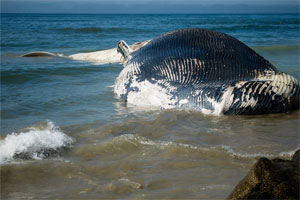 Carcass of a Blue Whale, Balaenoptera musculus
Carcass of a Blue Whale, Balaenoptera musculus
Credit: analog chainsawWhen zoologists speak about superlatives among animals, blue whales (Balaenoptera musculus) often play a key role at the high end of the scale of organisms. With good reason, too: they are not only the largest baleen whales, but also the largest mammals ever to have lived -- no mammoth, rhino or hippo, extinct or living comes close. Blue whales are also in the contest for largest backboned animal ever, measuring up against some of the largest dinosaurs. When blue whales and their close relatives open their mouths to feed, some scientists calculate they can even engulf a volume of water the size of a school bus. And, here in California, we are lucky enough to have blue whales right off our coast.
Blue whales often frequent the coast of southern California, especially to feed in the nutrient-rich waters of the Southern California Bight. Unfortunately, this feeding preference puts this population of blue whales (numbering perhaps in the few thousands) directly in the same area where many shipping lanes converge, near Long Beach and San Diego. This situation is all the more crucial for blue whales, whose population size is a mere shadow of its former self. For most of the twentieth century, blue whales teetered on the brink of extinction, as industrial whaling in the 1940s-1960s reduced blue whale populations in both the North and South Pacific Ocean. Cetologists (scientists who study cetaceans) still are trying to understand the exact magnitude of this decimation, and its effects on the genetic viability of the species, as well as potential ecological outcomes.
Inevitably, as the population recovers, we'll be seeing more of what happened a few weeks ago, near Ventura: a blue carcass, 78 feet long, washed up on the beach, within throwing distance of a county park. Early clues seem to indicate that the whale died from ship strike, although it will probably be some time before the final word is in. Disposing of such a carcass, however, is no trivial issue -- check out this video of what the Oregon State Highway patrol did to resolve one sperm whale standing (and its disastrous aftermath). Let's hope Ventura County officials forgo the dynamite solution, in this case.
![]() Nick Pyenson is a PhD candidate at the University of California, Berkeley, in the department of integrative biology and the museum of paleontology.
Nick Pyenson is a PhD candidate at the University of California, Berkeley, in the department of integrative biology and the museum of paleontology.
